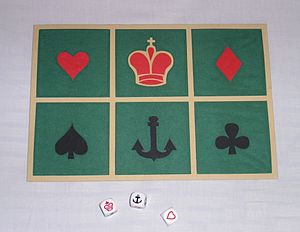Batch 2 - Class 17 - Probability, Binary, Misc
Pre-class problems:
- Game of Pig: A game works as follows - The first person to score 100 points wins. In each turn, a player can roll two dice as many times as they want. The total on those dice add to their score. However, if at any point, one dice turns up "6", then the score for that chance goes to zero. If both dice turn "6", then their entire score goes to zero. Think about a strategy to win the game. You may use this http://nrich.maths.org/1258 to play.
Attendance Rhea, Anisha, Muskaan, Tishyaa, Aastha, Kushaan, Aryan
Class puzzles
- Game of PigGet kids to play and get to a realization that quitting too early or too late is not good. So there is some sort of a "good number" to quitPromote the notion of wanting to advance the score as much as possible on each turn (limit to only "one six" scenario)Help find the balance by introducing notion of "what you expect to gain should be more than what you expect to lose", hence arrive at 13 as the cross over pointUsing same argument, illustrate that its not worth worrying about double sixes. Also reason that as a risk which always remains regardless of whether you quit now or notBring in an element that the answer is not always right - depends on where the competitor is. If the competitor is sitting at 95, then you might have to take higher riskhttp://www.durangobill.com/Pig.html for more detailed analysis and exact strategyAt each minute, an insect must move an edge of a cube in the "cube world". The insect can escape the cube world, if it lands up back where it started after seven minutes. What are the chances of it escaping?
- (Manas Contributed) - There is a rabbit which is some distance away from pizza slice. In each step, the rabbit covers half of the remaining distance to the pizza. In how many steps does the rabbit reach the pizza?Answer: Never
Instructor Note: Illustrate that a finite distance can have infinite steps
- (Shakuntala - 92) A ball is dropped from height of 8 ft and bounces off back to half the height every time. What is total distance before it comes to restAnswer: 24
Instructor Note: Illustrate with a ball. Idea is to familiarize with sequences and the notion that infinite sequences can have finite sums. Followup: Familiarize students with a series 1+1/2+1/4+1/8. Show the sum of circles in triangle visualization, from Khan Academy. Use the circles visualization to motivate another sequence, such as 1+1/3+1/6+1/9. In comparison to last problem, illustrate that infinite steps can lead to finite distance, and in multiple ways (use circles visualization)
- (MC Chap 0, Prob 19) - Distribute 127 one dollar bills among 7 wallets so that any integer sum from 1 to 127 can be paid without opening a wallet.Answer: Binary numbers 1, 2, 4, 8, 16, 32, 64
Instructor Note: Illustrate with beads with smaller number say 31. Idea is to motivate an alternate counting notion (dont press too hard on explaining binary math but introduce if kids feel comfortable)
Homework Game: Crown and Anchor - You have a board marked with 6 symbols (crown, anchor, diamond, spade, club and heart - but we will use 1-6 numbers), and dice marked with same symbols. You place a bet at any one square, and then roll three dice. If one dice comes up with the same symbol where you placed the bet, you get twice the amount; if two dice turn up, you get three times; and if 3 dice turn up, you get 4 times.
- If you play with two dice (double money on one hit, triple on 2 hits), what would you expect to win or lose?
- If you play with three dice (regular game), what would you expect to win or lose?
- Do the odds change if you bet on two numbers simultaneously? (either in two or three dice game)
- Is there a strategy a player can adopt to always win on a particular day?
- What happens if you have a fourth dice (and 5x payout if all four turn up the bet symbol)?

Answer: 92.1% probability of take back on any particular game, so house has an edge. If you bet on two numbers simultaneously, the average take back is still 92.1% (Its like two people playing the game on same board). To always win, you can use the strategy of doubling the bet on every successive game. With four dice, the odds rise to 1.18, so the house loses!
Homework trivia: why do we say "curiosity killed the cat"
References:
Mathematical Circles (Russian Experience), by Dmitri Fomin, Sergey Genkin, Ilia Itenberg
More Puzzles, by Shakuntala Devi
http://en.wikipedia.org/wiki/Crown_and_Anchor Solution computation in Dropbox Math Circles folder